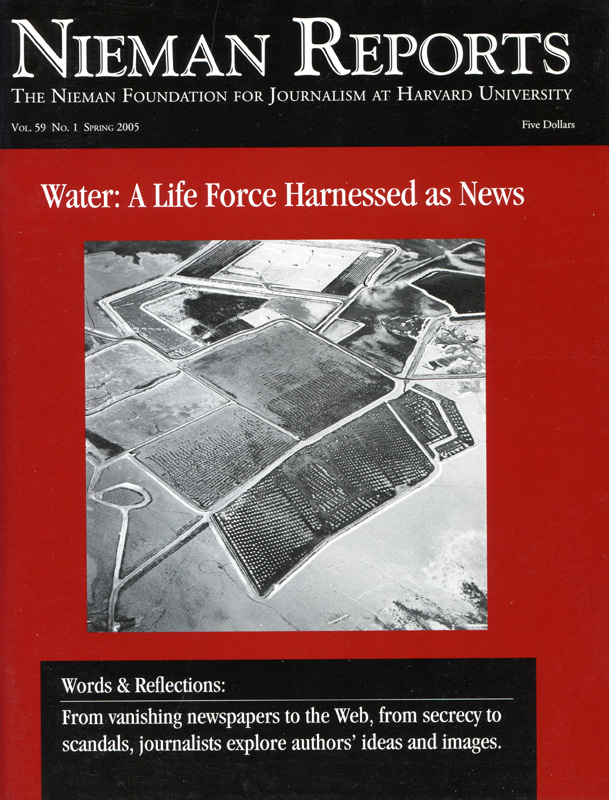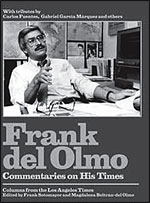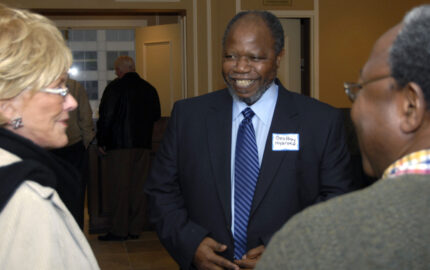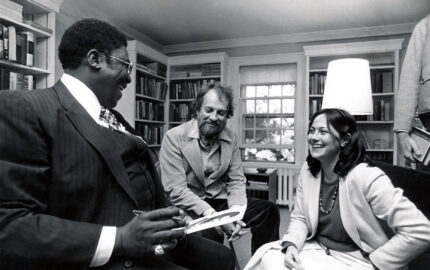The “two Franks.” That’s what some Los Angeles Times colleagues called Frank del Olmo and me because we tackled so many projects together. I never imagined that our final endeavor together would occur after his death.
We had been scheduled to have a working lunch on that fateful day—February 19, 2004. Instead, shortly before noon, an editor rushed into my office saying Frank had been stricken. Soon, I was at the hospital with his wife, and we heard the words we didn’t want to hear: Frank was dead of a heart attack at age 55.
The question then became how best to memorialize this distinguished journalist, a trailblazer for Latino media professionals and a pioneer in writing about autism. Frank’s wife, Magdalena Beltrán-del Olmo, Times Editor John Carroll and I quickly came to an agreement: a book of Frank’s best columns.
Within six months, “Frank del Olmo: Commentaries on His Times” rolled off the presses. It is a fitting tribute to someone who forged his way into U.S. journalism history—as cofounder of two professional news organizations, the first Latino masthead editor at the Los Angeles Times, and an influential columnist on contemporary events.
Read excerpts from columns that appear in the book, “Frank del Olmo: Commentaries on His Times:” »For a quarter of a century, Frank’s columns spoke forcefully about developments in politics, education, labor, immigration, media and sports. And in his last decade, Frank also wrote moving accounts as the compassionate father of a young son who is autistic. With eloquence springing from the heart, he described how he and Magdalena had first felt pain—and later hope—about the condition of Frankie, the boy with “the soft, sweet smile and big brown eyes.”
Ideally, this Los Angeles Times book would have been published while Frank was alive. But as Magdalena wrote, Frank always felt there were “more important battles to wage.” The task of selecting 90 of Frank’s best columns fell to her and me. As coeditors, we felt we made informed choices of what columns Frank would have wanted included. Magdalena, whom Frank had called “my very best editor,” had conferred regularly with her husband as he developed his commentaries over the 14 years they were together.
I had known Frank as a friend and colleague for 33 years at the Times. Besides being “tocayos” (Spanish for namesakes), we were both Mexican-American journalists from low-income families and passionate advocates for diversity and inclusive coverage of Latinos and other underserved communities. We worked together on a Times series on Latinos in Southern California that won the 1984 Pulitzer Prize for Public Service. And each of us spent a memorable year at Harvard as Nieman Fellows.
When Frank arrived in Cambridge in 1987, he was an outstanding reporter, foreign correspondent, and editorial writer. The Nieman experience and wise mentoring by Curator Howard Simons gave him skills and confidence “to break through the glass ceiling,” Magdalena recalled. A year after Harvard, Frank was promoted to deputy editorial page editor. Through this position and his later job as associate editor, he joined the newspaper’s masthead of top editors.
With Frank’s access to the editor’s and publisher’s suites and my feet in the newsroom trenches as assistant city editor, we emphasized to one management team after another the importance of providing more complete coverage about Latinos, who soon will become the majority ethnic populations in Los Angeles.
In the late 1970’s, the Times accepted our recommendation that “Latinos” become the newspaper’s style, instead of the bureaucratic-sounding “Hispanics.” At first, the Times was nearly alone in using the term, but over time it has won increasing national acceptance.
While Frank wrote through Latino eyes, the core themes he explored in his columns—the quest for truth and justice— are universal. In his best-known commentary, he authored a “dissenting opinion” to the newspaper’s 1994 endorsement of then-Governor Pete Wilson. He assailed Wilson for “cynically backing” the anti-illegal immigrant Proposition 187 as a divisive ploy for his reelection campaign.
Frank was devoted to his family: Magdalena, Frankie, age 12, and a daughter by a previous marriage, Valentina, 29. He told readers in December 2003 that he intended to write fewer columns and spend more time with Frankie. That intention never came true; sadly, he died within two months of writing those words. But as Frankie has said, he knows his father was a great man who loved him.
To signify Frank’s contributions to journalism, the California Chicano News Media Association and the National Association of Hispanic Journalists have begun presenting scholarships and awards in his name.
Frank’s friend of many years, author Gabriel García Márquez, a former reporter, wrote that he wished he “hadn’t read the news of Thursday, February 19: Frank del Olmo was dead and no disclaimer or correction was possible. Those of us who are born journalists discover early in our lives, and often against our will, that our craft is not just a calling, a fate, a need or a job. It’s something we can’t avoid: It is a vice among friends.”
I miss Frank, mi compadre. Outside the newsroom, we played softball together for the Chicano Cubs, sang along to mariachi ballads, and shared pride in our children. Working on this book was my way to honor our friendship and our journalistic calling. His words live on.
Frank O. Sotomayor, a 1986 Nieman Fellow, is a Los Angeles Times editor. He is assistant director of the Minority Editorial Training Program (METPRO) and editorial chair of the newspaper’s Student Journalism Program. The book “Frank del Olmo: Commentaries on His Times” is available at www.latimes.com/frankdelolmo.
We had been scheduled to have a working lunch on that fateful day—February 19, 2004. Instead, shortly before noon, an editor rushed into my office saying Frank had been stricken. Soon, I was at the hospital with his wife, and we heard the words we didn’t want to hear: Frank was dead of a heart attack at age 55.
The question then became how best to memorialize this distinguished journalist, a trailblazer for Latino media professionals and a pioneer in writing about autism. Frank’s wife, Magdalena Beltrán-del Olmo, Times Editor John Carroll and I quickly came to an agreement: a book of Frank’s best columns.
Within six months, “Frank del Olmo: Commentaries on His Times” rolled off the presses. It is a fitting tribute to someone who forged his way into U.S. journalism history—as cofounder of two professional news organizations, the first Latino masthead editor at the Los Angeles Times, and an influential columnist on contemporary events.
Read excerpts from columns that appear in the book, “Frank del Olmo: Commentaries on His Times:” »For a quarter of a century, Frank’s columns spoke forcefully about developments in politics, education, labor, immigration, media and sports. And in his last decade, Frank also wrote moving accounts as the compassionate father of a young son who is autistic. With eloquence springing from the heart, he described how he and Magdalena had first felt pain—and later hope—about the condition of Frankie, the boy with “the soft, sweet smile and big brown eyes.”
Ideally, this Los Angeles Times book would have been published while Frank was alive. But as Magdalena wrote, Frank always felt there were “more important battles to wage.” The task of selecting 90 of Frank’s best columns fell to her and me. As coeditors, we felt we made informed choices of what columns Frank would have wanted included. Magdalena, whom Frank had called “my very best editor,” had conferred regularly with her husband as he developed his commentaries over the 14 years they were together.
I had known Frank as a friend and colleague for 33 years at the Times. Besides being “tocayos” (Spanish for namesakes), we were both Mexican-American journalists from low-income families and passionate advocates for diversity and inclusive coverage of Latinos and other underserved communities. We worked together on a Times series on Latinos in Southern California that won the 1984 Pulitzer Prize for Public Service. And each of us spent a memorable year at Harvard as Nieman Fellows.
When Frank arrived in Cambridge in 1987, he was an outstanding reporter, foreign correspondent, and editorial writer. The Nieman experience and wise mentoring by Curator Howard Simons gave him skills and confidence “to break through the glass ceiling,” Magdalena recalled. A year after Harvard, Frank was promoted to deputy editorial page editor. Through this position and his later job as associate editor, he joined the newspaper’s masthead of top editors.
With Frank’s access to the editor’s and publisher’s suites and my feet in the newsroom trenches as assistant city editor, we emphasized to one management team after another the importance of providing more complete coverage about Latinos, who soon will become the majority ethnic populations in Los Angeles.
In the late 1970’s, the Times accepted our recommendation that “Latinos” become the newspaper’s style, instead of the bureaucratic-sounding “Hispanics.” At first, the Times was nearly alone in using the term, but over time it has won increasing national acceptance.
While Frank wrote through Latino eyes, the core themes he explored in his columns—the quest for truth and justice— are universal. In his best-known commentary, he authored a “dissenting opinion” to the newspaper’s 1994 endorsement of then-Governor Pete Wilson. He assailed Wilson for “cynically backing” the anti-illegal immigrant Proposition 187 as a divisive ploy for his reelection campaign.
Frank was devoted to his family: Magdalena, Frankie, age 12, and a daughter by a previous marriage, Valentina, 29. He told readers in December 2003 that he intended to write fewer columns and spend more time with Frankie. That intention never came true; sadly, he died within two months of writing those words. But as Frankie has said, he knows his father was a great man who loved him.
To signify Frank’s contributions to journalism, the California Chicano News Media Association and the National Association of Hispanic Journalists have begun presenting scholarships and awards in his name.
Frank’s friend of many years, author Gabriel García Márquez, a former reporter, wrote that he wished he “hadn’t read the news of Thursday, February 19: Frank del Olmo was dead and no disclaimer or correction was possible. Those of us who are born journalists discover early in our lives, and often against our will, that our craft is not just a calling, a fate, a need or a job. It’s something we can’t avoid: It is a vice among friends.”
I miss Frank, mi compadre. Outside the newsroom, we played softball together for the Chicano Cubs, sang along to mariachi ballads, and shared pride in our children. Working on this book was my way to honor our friendship and our journalistic calling. His words live on.
Frank O. Sotomayor, a 1986 Nieman Fellow, is a Los Angeles Times editor. He is assistant director of the Minority Editorial Training Program (METPRO) and editorial chair of the newspaper’s Student Journalism Program. The book “Frank del Olmo: Commentaries on His Times” is available at www.latimes.com/frankdelolmo.




